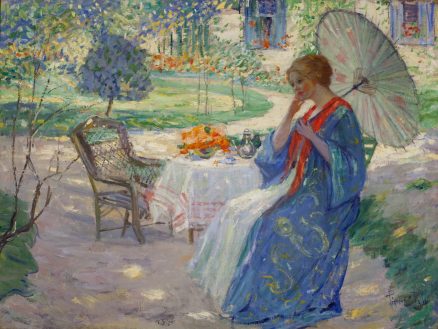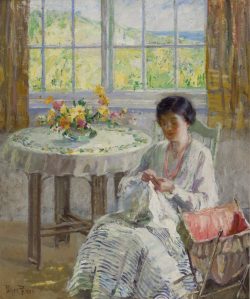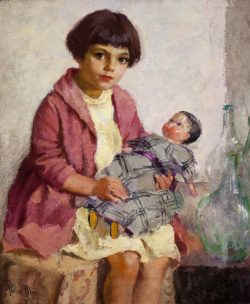- Categories
- Landscapes
- Women
- Women artists
- Zoom in on Artwork
- Print Page
- Email Page to Friend
Pauline Palmer’s image is a study in vivid color contrasts and the play of dappled shadow and bright light. Propping an oriental parasol on one shoulder, the female model wears the loose dress of morning leisure, including a blue kimono with a swirling pattern in gold and a red collar. The table at which she sits, with its silver coffeepot, is set for an alfresco breakfast perhaps to be shared with a companion, as indicated by the empty wicker chair. Behind her, the garden path stretches away toward the sunlit facade of a house with blue-shuttered windows. While Palmer carefully modeled the woman’s face, she captured much of the rest of the scene with the loose brushstrokes characteristic of impressionism; at the upper left in particular, distinct dabs of color suggest a dense screen of lush summer foliage. The shadowing of the foreground and figure in contrast to the bright background emphasizes the picture’s illusion of deeply receding space.
This painting probably dates to or soon after the summer of 1910, when Palmer worked in the international colony of impressionist painters gathered in Giverny, France. She likely went there to join American expatriate artist Richard Emil Miller, with whom she had studied in Paris and would work again in Provincetown, Massachusetts. Between 1909 and the outbreak of World War I, Giverny was dominated by a “third generation” of impressionist painters who included in addition to Miller several figural painters with ties to Chicago, notably Karl Anderson, Karl Buehr, Frederick Frieseke, Lawton Parker, and Louis Ritman. All specialized in images of beautiful women at leisure, frequently picturing them outdoors in the garden settings of the artists’ own rented residences in the village. Kimonos, parasols, and open-air breakfasts are features of many of these portrayals, which also share luscious color, vividly textured brushwork, and themes of languid domesticity.
Several months after Palmer’s stay in the French village, Chicago Tribune art critic Harriet Monroe wrote of the Giverny group and its salutary influence on Chicago painters who had visited there for a season: Palmer, she reported, “said she was learning lessons of inestimable value, and getting rid of faults which had hardened her work for years.”i Of the seven paintings the artist had recently exhibited in the Art Institute of Chicago’s annual exhibition for Chicago artists, two bore titles indicating a Giverny setting. Another, titled In the Garden, might be this painting. With her work in France and Italy in 1910, Palmer made a decisive shift toward the impressionist mode of heightened color and bright light with which she remains associated.
Wendy Greenhouse, PhD
Donated by M. Christine Schwartz to the Provincetown Art Association and Museum, Provincetown, Massachusetts, in 2021
i Harriet Monroe, “Do We Really Underestimate the American Artists?” Chicago Tribune, May 28, 1911.


